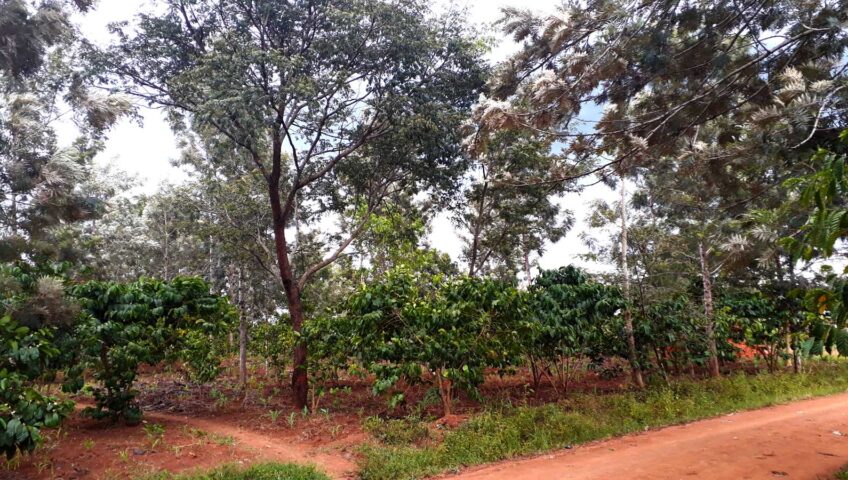What do you picture when you think of biodiversity? Lush forests teeming with birds? Or maybe coral reefs bursting with fish and brightly coloured corals? Now think about a farm as a symbol of biodiversity. Likely, farms are not the first landscapes to conjure images of species richness, but Trees on Farms for Biodiversity want people to think differently and consider the potential of farms to strengthen food systems and improve food security for humans and provide habitat security for plants and wildlife. And they are building new tools to support this approach.
Trees on Farms for Biodiversity is a joint programme that supports agriculture and livelihoods through conservation by incorporating trees in managed and productive ecosystems to generate both ecological and societal benefits. Trees on Farms for Biodiversity (TonF) concluded three workshops in April and May 2021, with the five host countries –
Rwanda, Indonesia, Peru, Honduras and Uganda – to generate policy and science exchanges and share new ideas for increased impact and implementation.
To open the workshop series, participants took stock of the progress status of Aichi target 7 and how this informs the current discussions of the new targets for agricultural landscapes and their restoration and conservation under the UN Convention on Biological Diversity (CBD) post-2020 global biodiversity framework. The TonF team presented the key messages used to advocate for a more holistic view of agricultural landscapes as a source of bioversity and ecosystem services. To measure and monitor biodiversity elements in managed and productive ecosystems, participants learned about new biodiversity assessment tools which aim to be used at the national level in the context of monitoring implementation of the post-2020 global biodiversity framework.
Within the CBD Sixth National Report, new language describes increasing sustainability, resilience and productivity while reducing harmful inputs of fertilisers and pesticides on agricultural and working landscapes. These augmented targets for agriculture are an opportunity to expand species diversity while simultaneously supporting and stabilising agronomy in communities.
New tools for biodiversity
To evaluate the current landscapes in each of the TonF countries, new biodiversity monitoring tools were developed including remote-sensing landscape biodiversity assessment protocols and a Farmland Biodiversity Score. The remote-sensing tool uses ground-truthed data on biomass and tree composition to create detailed landscape scale maps. The Farmland Biodiversity Score models attributes of the landscape and their interactions to assess the biodiversity value of agricultural landscapes and scores can be aggregated for political units. Both tools can be used to compare changes in the landscape over time or to track attributes of interest to determine increasing or decreasing biodiversity. Workshop participants expressed their interest in applying the tools. For example, in Indonesia the assessment tools can identify areas of value to conserve important tree species for conservation within oil palm and coffee plantations.
Host country approaches
Decision-makers from the host countries summarised current approaches for integrating trees on farms and monitoring biodiversity levels. Facing rapid development, which creates forest fragmentation, Indonesia is looking to integrate agroforestry to improve degraded lands and increase biodiversity on farms, including multipurpose tree species that provide food and economic stability to communities. Uganda is ripe for innovations like monitoring through natural capital accounting and collaborating with local and international organisations to reach smallholders nation-wide. Honduras is endeavouring to create a culture of sustainable use and protections for biodiversity in national policy. Meanwhile, Honduran ranchers are replacing pasture fencing with live fences and expanding the tree species they employ to attract more wildlife. Peru is finding a better path for productivity near protected lands, especially the Amazon, connecting agriculture to conservation and climate change sectors within government. A successful farming solution in Rwanda includes trees on terraced hillsides, which increases retention of arable soil, supporting communities and livelihoods. Rwanda policies are further focusing on agroforestry in their frameworks and reducing harmful farm subsidies that affect wildlife.
Farmland adds to biodiversity
Preliminary results presented during the workshops showed that while natural forests have the highest levels of biodiversity, agroforestry landscapes supported higher species richness for trees, birds, mammals and insects than arable monocrops, pasture and other land use types. Adding trees to farms and pastures could create a network of corridors, connecting forest fragments and expanding ranges of species. The added value for people comes in the form of food and nutrition security and economic benefits through harvesting fruit trees, selling timber, and providing fodder for livestock.
Just as trees on farms brings agriculture and forestry conservation together, the TonF biodiversity monitoring workshop brought together policy makers, researchers, agriculturalists and programme coordinators to learn new tools to assess the increase of species richness through tree plantings on farmland and other landscapes for long-term sustainability and resilience.
Although challenges persist, agroforestry in all its forms provides a positive pathway for countries to meet their economic, social, and enviornmental needs and to fulfil their biodiversity targets. For countries trying to meet these targets and provide for their populations, expanding diversity on farms, ranches, degraded lots and public and private lands is a welcome and straightforward solution to benefit wildlife and people.
-Web story by Sarah Brommer Nash

